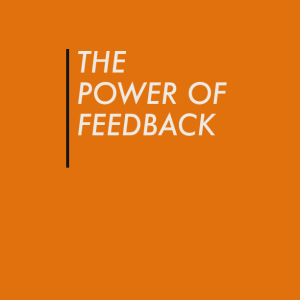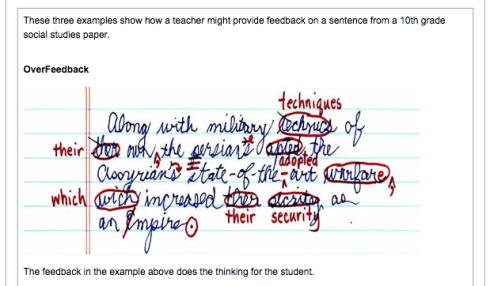 I worry my middle name might be Sisyphus. Despite my best efforts, the inevitable piles of essays that are a part of my working life too often feel like boulders to move from here to there. I desperately want to see each essay as another rich opportunity, a chance to help a budding writer find her voice. At my best, I find this state of mind. Yet, the amount of time required to respond to student work always leaves me with one nagging question: “Is all of this really working?” Thankfully, my tendency to question (*cough: despair about) the effectiveness of my feedback can lead to fruitful reflection.
I worry my middle name might be Sisyphus. Despite my best efforts, the inevitable piles of essays that are a part of my working life too often feel like boulders to move from here to there. I desperately want to see each essay as another rich opportunity, a chance to help a budding writer find her voice. At my best, I find this state of mind. Yet, the amount of time required to respond to student work always leaves me with one nagging question: “Is all of this really working?” Thankfully, my tendency to question (*cough: despair about) the effectiveness of my feedback can lead to fruitful reflection.
Lately I have explored how to ensure my time (and my students’ time) is spent most effectively. For the past two years, my fellow English teachers and I set a departmental goal of improving the efficacy of our feedback. This year a few of us tackled John Hattie’s and Helen Timperley’s “The Power of Feedback,” a very extensive review of educational research on what really works in regard to teacher feedback on student work. This 2007 white paper deals with big data, reviewing hundreds of studies sampling thousands (maybe millions?) of students. The paper is dense and technical and big…but it is also illuminating and practical and useful. If you have the time, the study is worth a read. Of course, you probably don’t and just want somebody to give a summary…so keep reading.
I will dedicate the next several posts to reactions to and reflections on this publication (and others I have explored as a result). Also, to anchor theory to my work-a-day life, I will summarize our discussions by reflecting on my own practices.
 TAKE-AWAY #1: Feedback should help students answer these three questions: Where am I going? How am I going? Where to next?
TAKE-AWAY #1: Feedback should help students answer these three questions: Where am I going? How am I going? Where to next?
“Feedback is effective to the degree to which it directs information to enhanced self-efficacy and to more effective self-regulation, such that attention is directed back to the task and causes students to invest more effort or commitment to the task” (Hattie and Timperley 95).
In other words, feedback is most effective when it puts the “heavy lifting” of thinking back on the students and encourages them to re-work their work. It’s a simple idea when written, but a more complicated task to carry out with living, breathing teenagers. These three questions can focus our efforts.
Alan November puts it a slightly different way. When he visits a classroom, to quickly tell if instruction is effective, he asks students two questions: “What are you suppose to be learning? How are you doing toward that goal?” If students can answer these questions, the instruction is working. If they can’t, it probably isn’t.
I know I can improve in my ability to help students answer these three questions more often. Reflecting on my own practices, here is the good, the bad, and the ugly:
The Good:
I have written before about some of the time-saving techniques I use to mark essays. The practice of “Free My Grade” (first point in the linked blog post) is a good one according to research. Students are forced to process my comments, reflect on the scoring guide, and articulate what they need to do to improve. Most importantly, they immediately get the chance to put the feedback to use right away. I use this step all the time, and to improve it, I will have students answer the three questions directly.
I have recently used “Green Pen/Yellow Pen” to give feedback. I learned this simple idea in a recent professional development session on differentiation. Highlight something that is working in green. Highlight something that is NOT working in yellow. (I limit myself to about ten total highlights). Hand the paper back to the students and then have them write why you highlighted the section in the particular color. I impose an “ask three before you ask me” rule (ask yourself and then the people sitting to your left and right before asking me). When a student does not know why I have highlighted something in yellow, for instance, before answering I will ask something like, “Well, if you did know why I highlighted it, what would your answer be?” or “Give me an educated guess and then I will tell you what is wrong.” It’s a simple process that leads to big gains in their writing. Here is a DIRECTIONS FOR CORRECTIONS handout you can adapt if you want to try this technique, too.
Both of these actions turn the duty of analysis back to the students. Hattie and Timperley note, “Teachers need to view feedback from the perspective of the individuals engaged in the learning and become proactive in providing information addressing the three feedback questions and developing ways for students to ask these questions of themselves. Students, too often, view feedback as the responsibility of someone else, usually teachers, whose job it is to provide feedback information by deciding for the students how well they are going, what the goals are, and what to do next” (101). “Free My Grade” and “Green Pen/Yellow Pen” (or any two color of pens) are two techniques I have been using that are in line with research. I have always known, throw observation of my students’ work, that these practices work, but it is good to be validated by big data as well.
The Bad:
I would love to be a perfect feedback giving machine. I am not. I take some comfort in knowing you aren’t either. I am very guilty of providing too much feedback (and writing blog posts that are too long…this one is almost done, promise).
In “How Am I Doing” by Jan Chappius I found these graphics that illustrate a mistake I make too often….doing too much work for the students.
I have written in the past about how I use macros to standardize my written comments and save some time. In that post I shared this example of the typical feedback I give a paper, and while I am not marking every mistake, I feel I am doing too much work for the student. (And, in other instances I have certainly “bled” all over student work like in the above example).
Chappius recommends we avoid robbing students of these opportunities to think. She gives this suggestion to avoid such ugly feedback practices:
I must admit that as a student I would find the example above a bit confusing, but the spirit of this feedback is very laudable. During one-on-one discussions in the classroom, I highlight a sentence and say to a student, “There are ‘x-number’ of language errors in this sentence. Can you spot them?” Most often they can. This type of feedback means we cannot mark every mistake, but the feedback we do provide becomes more relevant.
An excerpt from “The Power of Feedback” puts this idea another way: “Learning can be enhanced to the degree that students share the challenging goals of learning, adopt self-assessment and evaluation strategies, and develop error detection procedures and heightened self-efficacy to tackle more challenging tasks leading to mastery and understanding of lessons.” (103)
The Ugly:
 As a young teacher I made this mistake all the time. I make it less often now. In my role as year head I do see some of my colleagues giving such vague, antagonistic feedback. They aren’t doing it because they want to waste time. I think they probably think, “Well, this is how I learned” or “This is what I have time to do!? What else can I do?” Yet, I also think we know, deep in our hearts, that feedback like this does not really work. We can and should do better. Of course, research supports this notion, too.
As a young teacher I made this mistake all the time. I make it less often now. In my role as year head I do see some of my colleagues giving such vague, antagonistic feedback. They aren’t doing it because they want to waste time. I think they probably think, “Well, this is how I learned” or “This is what I have time to do!? What else can I do?” Yet, I also think we know, deep in our hearts, that feedback like this does not really work. We can and should do better. Of course, research supports this notion, too.
Researchers Thompson and Richardson state: “Unclear evaluative feedback, which fails to clearly specify the grounds on which students have met with achievement success or otherwise, is likely to exacerbate negative outcomes, engender uncertain selfimages, and lead to poor performance” (qtd. in Hattie and Timperley 95). Making any personal remarks like “You’re being lazy” or “Try harder next time” simply leads to frustration and resentment, not learning. Such generality wastes everyone’s time.
Obviously, I have quite a bit to write about feedback. I have been drafting this first post for a long time, trying to condense and organize. In my next few posts I will continue to deconstruct and archive our interesting conversations around this topic. I hope you find these posts helpful. You might also explore these links:




Maths Teacher here – like the one dot thing – yes it will annoy some of my students, but it might be the thing that makes them think and a good bridge with green pen/ pink pen – you are nicer than me – I went for the closest thing to red for bad comments.
What a great find. I am so messianic on the subject of feedback, I never really stopped to think about the different categories and which kind would be most or more effective. Thanks for drawing attention to the research, and posting a link to The Power of Feedback, which I am reading in bites in order to better understand the differences and their effects. Thank you!
Great post Robin…need to get your blog linked to the AAIE Best of International page soon! – Yolanda
Reblogged this on So, You Think You Can Teach ESL?.